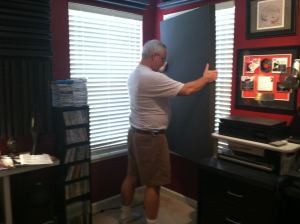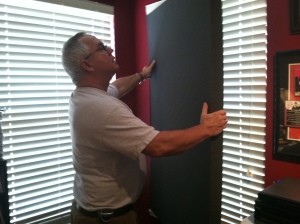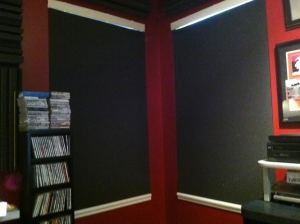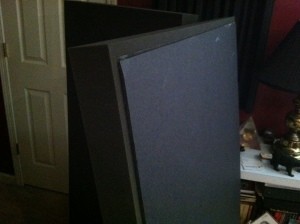
Seems many voice talents have been experiencing those “neighborhood noises” we have so little control over and shouting their anguish from the top of their lungs. Stop that! You’ll hurt yourself. There are some solutions.
I too had issues with the landscaping people mowing the grass around our condos and stopping me from the ability to record or do an ISDN session in peace. This can really be a pain-in-the-a** for our clients and our professionalism. If you are able, move your studio to the basement if you have an in-ground basement. Those cute little windows can be stuffed with insulation, old coats, unwanted neighbors, etc. to cut out that peripheral noise. Aim for a corner of the basement that is closest to the deadest area of your outside lawn. Perhaps a rock garden or pool – wait a minute – now you have to worry about the pool pump. Oh, never mind. And don’t forget the sump pump if you have one. AND…if you’re in a flood plain, you might re-think the basement idea altogether.
My home studio is on our second floor in the front. Believe me, it’s not a moveable item. (see studio picture) I have two windows that face the north & west. They’re the standard 35” x 60” sized bedroom window. When the landscaping company we hired mow the grass, edge and blow the grass clippings, that noise is definitely a problem for me for the grass below my window, across our street and around our retention pond, “Lake Eller”, on any given grass day each week during the summer. So, I contacted the folks at AURALEX, and they suggested I should measure my window openings for their Window Plugs (my term and I think theirs’s now too). I received two 2½ inch thick blocks of dense Auralex with a quarter-inch piece of what appears to Masonite on the outer window side. They fit perfectly to my window due to the custom measurements I gave them. When all is good, they sit off to the side in my studio absorbing extra noise in my room. However, on Grass Day, as soon as I hear them coming, I simply close my blinds and take the window plugs and push it into the window opening that sits flush with my walls. The lowest frequencies from the mowers still are audible to my ears, but clients on the other end don’t seem to hear it as well as I. However, the general noise is cut out well enough to proceed and make the investment worthwhile. (see pictures) Call them and speak to one of their engineers and explain what you need. They are very willing and quite capable to handle this situation. I love how they embraced my situation and came up with this answer.
So, I contacted the folks at AURALEX, and they suggested I should measure my window openings for their Window Plugs (my term and I think theirs’s now too). I received two 2½ inch thick blocks of dense Auralex with a quarter-inch piece of what appears to Masonite on the outer window side. They fit perfectly to my window due to the custom measurements I gave them. When all is good, they sit off to the side in my studio absorbing extra noise in my room. However, on Grass Day, as soon as I hear them coming, I simply close my blinds and take the window plugs and push it into the window opening that sits flush with my walls. The lowest frequencies from the mowers still are audible to my ears, but clients on the other end don’t seem to hear it as well as I. However, the general noise is cut out well enough to proceed and make the investment worthwhile. (see pictures) Call them and speak to one of their engineers and explain what you need. They are very willing and quite capable to handle this situation. I love how they embraced my situation and came up with this answer.
As you can see by the pictures of my studio, I believe in the Auralex product line. I don’t own any stock, just a happy customer who has had great luck with the sound of my room compared to the DIY baffles I used to use that hung on the walls of my first studio. They kinda worked. When you walk into my studio now, you know immediately that you are in an acoustically dampened room that sounds like it was made just for me. I love it!


Simple installation into window openings
Window Plugs installed


2.5 inches thick with Masonite backing for heat
reflection (faces towards window)
In an effort to get some specific information that’s above my knowledge, I contacted Auralex to get this info to legitimize this blog and its information for the benefit of our readers.
Hey Johnny,
Thank you for giving me the opportunity to contribute. Numerous famous voice talents, alive and deceased, cut their tracks in rooms with Auralex products. We’re heard daily on virtually all media.
These are custom solutions, as no one size fits all windows, nor solves all specific problems. The backing boards we put on yours lend rigidity, which helps keep the plugs from sagging, but also increases the low-frequency absorption of the system, turning the system + air gap + window into a more-effective bass trap than would be achieved if Studiofoam® or PlatFoam™ alone were utilized. ALL small rooms need additional bass trapping (to a much larger degree than almost anyone realizes, which is why I often lecture on this topic at universities); window plugs are a way to gain bonus bass trapping, not to mention additional, general acoustical control in the room. Window plugs can be considered, based on their typical size and construction, to be more broadband absorbers than typical acoustical treatments that might be thinner and boundary-mounted, thus offering less low-frequency absorption.
We can provide our proprietary PlatFoam in variable thicknesses to suit customers’ space and sonic requirements. PlatFoam is denser and uses different cell structure than our world-famous Studiofoam®. Backing boards, and even intermediate boards of various materials and densities, are available; these can improve sound isolation and absorption, specifically at low frequencies. Cloth-covered panels utilizing different substrates, including layered and varying ones, are available; window plugs can coordinate visually with Auralex ProPanels™. Auralex SheetBlok™ sound barrier can be included; its STC (Sound Transmission Class) of 27 is more effective than a sheet of lead of the same thickness…and a lot safer to be around, yet the product is only 1/8″ thick. It is highly recommended for inclusion in window plugs.
Both PlatFoam and Studiofoam feature our proprietary chemistry that exhibits incredible longevity. This can be especially important when used in direct sunlight in a window opening, with or without a backing board. 
Plugs can be custom fabricated using acrylic and transparent SheetBlok™ sound barrier material for those who desire to retain as much light infiltration as possible.
Panels can be designed per customer guidelines and can include handles if desired, so as to facilitate installation and removal.
The sky is truly the limit. That’s why we don’t offer a one-size-fits-all solution for window plugs.
Unless studio use-specific windows were included in construction, windows are typically the weak link in the sound isolation chain. Improving their seals can help, but window plugs are more effective. Another thing some customers might consider is mounting another window, or piece of laminated glass, in front of their existing window. Auralex products can also be used to construct DIY solutions that mount around the entire existing window and can be removed when desired. Options abound.
Speaking of laminated glass, we fully outline the correct way to build your own sound-occlusive window in our free publication and website www.Acoustics101.com (Acoustics101™ is a trademark and is property of Auralex Acoustics, Inc. Others have tried to use it, but our attorneys had a field day with them.) Most people, even some studio designers, make mistakes when choosing the glass from which to construct their windows. Get it wrong and the system will be a virtual “open window” to sound.
We’re always happy to discuss custom solutions with people. They can fax, mail or e-mail their ideas, requirements, budgets and photos to us. We’re good at figuring out the best way to solve individual problems and have been bending the laws of physics and finance worldwide for 34 years.
If I can contribute any additional info to this article, or any future articles about studio acoustics for V/O, let me know.
Eric Smith
Founder & President
Auralex Acoustics, Inc.
Cell 317-440-2992
www.auralex.com
www.acoustics101.com
www.auralexuniversity
www.auralexELiTE.com
[Editor’s Note: This blog article has been reprinted with permission in VoiceoverXtra.com]
Amy Taylor, a fellow VO artist had some suggestions:
1) Record during periods when you know it will be quiet. This might mean keeping a log that details the intervals and times that buses go by or when the neighbor has their lawn mowed.
2) Choose a different part of your home to record in. Maybe there is a better place soundproofing wise that you can record in. The environment might not be as inviting or bright, but if it improves the ambiance for recording, give it a shot to see if you can make a new arrangement work.
3) Build an isolation booth. There are ways that you can soundproof your recording space. A number of videos are articles are online about how you can do this. The solutions range from expensive whisper rooms to cheap do-it-yourself projects.
My walls are doubled, and the R factor of the insulation is the best I could get when we built this. Most of the noise comes in via the window. My next move WILL have an isolation booth.
Doin’ the best that I can…